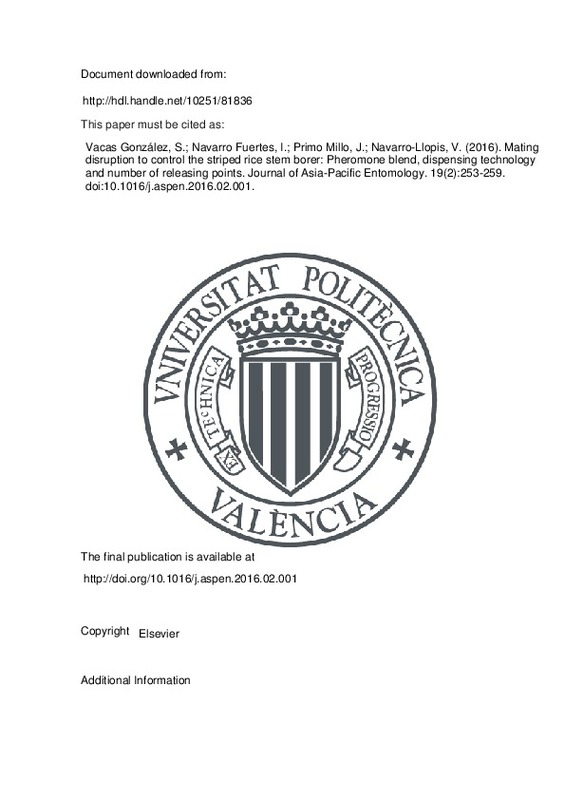JavaScript is disabled for your browser. Some features of this site may not work without it.
Buscar en RiuNet
Listar
Mi cuenta
Estadísticas
Ayuda RiuNet
Admin. UPV
Mating disruption to control the striped rice stem borer: Pheromone blend, dispensing technology and number of releasing points
Mostrar el registro sencillo del ítem
Ficheros en el ítem
| dc.contributor.author | Vacas González, Sandra
|
es_ES |
| dc.contributor.author | Navarro Fuertes, Ismael
|
es_ES |
| dc.contributor.author | Primo Millo, Jaime
|
es_ES |
| dc.contributor.author | Navarro-Llopis, Vicente
|
es_ES |
| dc.date.accessioned | 2017-05-26T12:16:48Z | |
| dc.date.available | 2017-05-26T12:16:48Z | |
| dc.date.issued | 2016 | |
| dc.identifier.issn | 1226-8615 | |
| dc.identifier.uri | http://hdl.handle.net/10251/81836 | |
| dc.description.abstract | The effect of using low densities of different dispensing technologies on mating disruption of the striped rice stem borer, Chilo suppressalis Walker, was evaluated in the rice-growing area of Valencia (Spain) from 2011 to 2013. The reduction of the current number of release points (30 polymeric dispensers/ha) was investigated by installing 3 aerosol devices per ha (Experiments 1 and 2) or with clusters of hand-applied dispensers (10 or 5 release points/ha; Experiment 3). The influence of pheromone blend on disruption was also studied by loading aerosol devices with the three-component blend or only the main pheromone compound, Z-11-hexadecenal. Results showed that the installation of 3 aerosol devices/ha or clusters of passive dispensers (total dose: 6.6-7.9 g/ha) proved equally effective as the conventional treatment with 30 Selibate (R) CS dispensers/ha (similar to 5 g/ha), reducing damage below 1% of infested plants. Although the treatment with 3 aerosol devices/ha loaded with Z-11-hexadecenal provided control of damage comparable to the conventional mating disruption treatment, the higher captures recorded suggest that mating disruption with the incomplete pheromone blend is only slightly effective in the tested conditions. These changes in the number of point sources and pheromone blend could represent important advantages for the implementation of mating disruption against C. suppressalis. (C) 2016 Korean Society of Applied Entomology, Taiwan Entomological Society and Malaysian Plant Protection Society. Published by Elsevier B.V. All rights reserved. | es_ES |
| dc.description.sponsorship | We would like to thank Francisco Girona, Vicente Dalmau and Manuel Lainez (CAPA-Generalitat Valenciana) for their assistance in organizing experiments and providing trial fields. In addition, thanks to Helen Warburton for English editing. This project was funded by Fundacion Agroalimed and Ecologia y Protection Agricola SL (Valencia, Spain). | en_EN |
| dc.language | Inglés | es_ES |
| dc.publisher | Elsevier | es_ES |
| dc.relation.ispartof | Journal of Asia-Pacific Entomology | es_ES |
| dc.rights | Reserva de todos los derechos | es_ES |
| dc.subject | Chilo suppressalis | es_ES |
| dc.subject | Aerosol dispensers | es_ES |
| dc.subject | Mesoporous dispensers | es_ES |
| dc.subject | Integrated pest management | es_ES |
| dc.subject | Paddy fields | es_ES |
| dc.subject.classification | QUIMICA ORGANICA | es_ES |
| dc.title | Mating disruption to control the striped rice stem borer: Pheromone blend, dispensing technology and number of releasing points | es_ES |
| dc.type | Artículo | es_ES |
| dc.identifier.doi | 10.1016/j.aspen.2016.02.001 | |
| dc.rights.accessRights | Abierto | es_ES |
| dc.contributor.affiliation | Universitat Politècnica de València. Instituto Agroforestal Mediterráneo - Institut Agroforestal Mediterrani | es_ES |
| dc.contributor.affiliation | Universitat Politècnica de València. Escuela Técnica Superior de Ingenieros Industriales - Escola Tècnica Superior d'Enginyers Industrials | es_ES |
| dc.description.bibliographicCitation | Vacas González, S.; Navarro Fuertes, I.; Primo Millo, J.; Navarro-Llopis, V. (2016). Mating disruption to control the striped rice stem borer: Pheromone blend, dispensing technology and number of releasing points. Journal of Asia-Pacific Entomology. 19(2):253-259. doi:10.1016/j.aspen.2016.02.001 | es_ES |
| dc.description.accrualMethod | S | es_ES |
| dc.relation.publisherversion | http://doi.org/10.1016/j.aspen.2016.02.001 | es_ES |
| dc.description.upvformatpinicio | 253 | es_ES |
| dc.description.upvformatpfin | 259 | es_ES |
| dc.type.version | info:eu-repo/semantics/publishedVersion | es_ES |
| dc.description.volume | 19 | es_ES |
| dc.description.issue | 2 | es_ES |
| dc.relation.senia | 328509 | es_ES |
| dc.identifier.eissn | 1876-7990 | |
| dc.contributor.funder | Ecología y Protección Agricola S.L. | es_ES |
| dc.contributor.funder | Fundación de la Comunitat Valenciana para la Investigación Agroalimentaria, Agroalimed | es_ES |







![[Cerrado]](/themes/UPV/images/candado.png)

